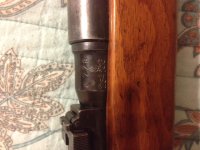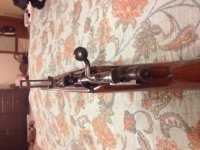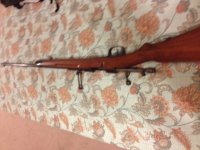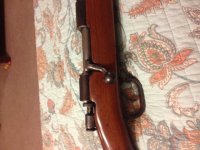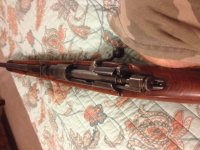You are using an out of date browser. It may not display this or other websites correctly.
You should upgrade or use an alternative browser.
You should upgrade or use an alternative browser.
unknown rifle
- Thread starter Firefighter
- Start date
Firefighter
Inactive
It appears to be a sporterized Type I Japanese rifle; the original caliber was 6.5 x 50 Japanese. Those rifles were made in Italy under a program inspired by "Der Führer" to boost the Italian economy by having the Japanese contract with the Italians for rifles. The action is basically a copy of the Italian Mannlicher-Carcano, but with the Mauser-type magazine of the Arisaka rather than the en-bloc clip of the Italian rifle. The bolt handle was originally straight; it was bent, probably at the same time the rest of the conversion was done. The Japanese presumably had some other name for that rifle, but the one most used here is "Type I", the "I" being for Italy.
The rifles were made in 1938-1939 and all were completed and shipped to Japan (via the USSR) before Germany declared war on Russia. Most went to the Japanese Navy (the Army did not want a non-standard rifle). A total of 60,000 rifles was made; half by the Italian government factory in Gardone, 1/4 by Beretta, and 1/4 by the government factory in Brescia. All the barrels were made by Terni.
Jim
The rifles were made in 1938-1939 and all were completed and shipped to Japan (via the USSR) before Germany declared war on Russia. Most went to the Japanese Navy (the Army did not want a non-standard rifle). A total of 60,000 rifles was made; half by the Italian government factory in Gardone, 1/4 by Beretta, and 1/4 by the government factory in Brescia. All the barrels were made by Terni.
Jim
Firefighter
Inactive
Thank you for your quick response I've spent hours on the web researching guns of that caliber and never came across a Type I. After a quick search "Thanks to you" I found several like it. Once again thank you!
Mike Irwin
Staff
I agree with Jim's assessment.
Basic Carcano action but with the Mauser-style integral staggered box magazine loaded with standard stripper clips instead of the Mannlicher packet clip magazine found on the Italian rifle.
The story I've heard for the origin of the rifle is that small arms arsenals in Japan were controlled by the Imperial Japanese Army. The IJA and the IJ Navy were quite bitter rivals and didn't work and play well together.
This, and the fact that the Army was rapidly increasing in numbers made it difficult for the Navy to obtain sufficient numbers of small arms.
IJN representatives approached Germany, Italy, and Czechoslovakia for their rifle needs. They liked the German-made rifles, but apparently they were too expensive, so they contracted with both Italian and Czech arsenals to produce rifles.
I'm assuming that the Czech-made guns (questionable if any were ever made/delivered given how things worked out in 1937-1939) were to be built on the standard Mauser design.
Basic Carcano action but with the Mauser-style integral staggered box magazine loaded with standard stripper clips instead of the Mannlicher packet clip magazine found on the Italian rifle.
The story I've heard for the origin of the rifle is that small arms arsenals in Japan were controlled by the Imperial Japanese Army. The IJA and the IJ Navy were quite bitter rivals and didn't work and play well together.
This, and the fact that the Army was rapidly increasing in numbers made it difficult for the Navy to obtain sufficient numbers of small arms.
IJN representatives approached Germany, Italy, and Czechoslovakia for their rifle needs. They liked the German-made rifles, but apparently they were too expensive, so they contracted with both Italian and Czech arsenals to produce rifles.
I'm assuming that the Czech-made guns (questionable if any were ever made/delivered given how things worked out in 1937-1939) were to be built on the standard Mauser design.
There are several versions of how the Type I came to be. The somewhat abbreviated one I gave (based on Honeycutt) seems to be the most common and has been around the longest. The story of Hitler's personal involvement also varies but it appears to be something that would appeal to the mind of der Führer, cementing his grand alliance. At least one version is that the IJN did not order the rifles and apparently had no idea what to do with them, as they had an adequate supply of small arms. Most, including the one I have and several others I have seen, appear to be unissued, but others show signs of fairly heavy use.
The production of rifles for Japan appears to have been a fairly important project for the Italian arms making system, involving three government arsenals and a private company, plus numerous subcontractors. Further, the undertaking of foreign work is significant when Italy needed all the arms it could make for its own re-armament. To an old bureaucrat (me), that level of effort and major involvement spells political pressure from "on high", not just a routine search for a new weapons source by Japan. And the small number (60,000) of rifles actually procured seems to indicate a token purchase to "keep the big shots happy" rather than any real need for weapons; that many were not issued even in the last desperate months seems to confirm the lack of any real need.
Jim
The production of rifles for Japan appears to have been a fairly important project for the Italian arms making system, involving three government arsenals and a private company, plus numerous subcontractors. Further, the undertaking of foreign work is significant when Italy needed all the arms it could make for its own re-armament. To an old bureaucrat (me), that level of effort and major involvement spells political pressure from "on high", not just a routine search for a new weapons source by Japan. And the small number (60,000) of rifles actually procured seems to indicate a token purchase to "keep the big shots happy" rather than any real need for weapons; that many were not issued even in the last desperate months seems to confirm the lack of any real need.
Jim

